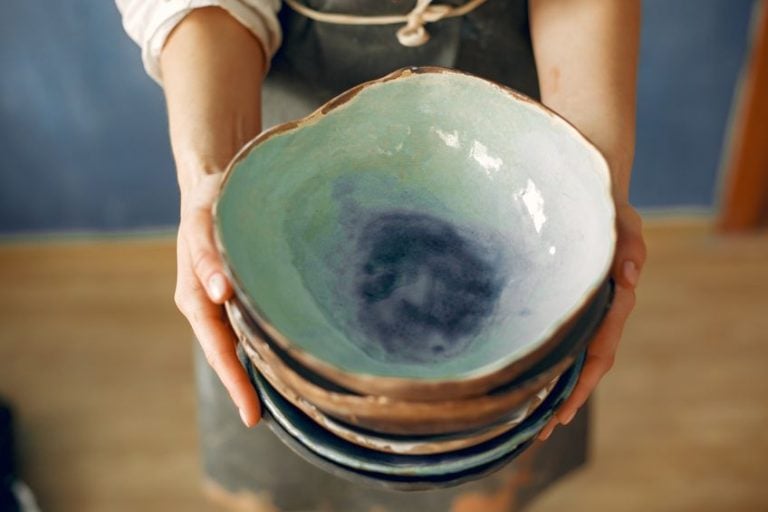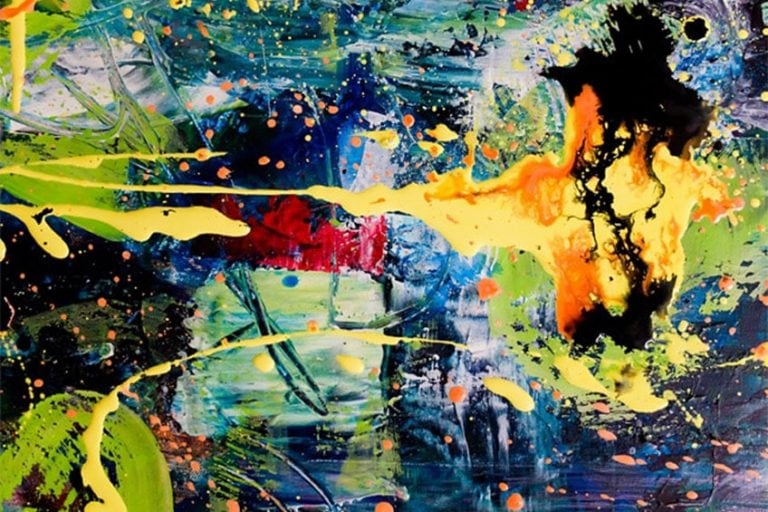Acrylic Pour Painting – Paint Pouring Techniques Guide
One of the more increasingly popular art forms or hobby ideas is fluid art painting. This is a wonderful technique of painting with acrylics that can easily be used by beginners. Pouring is also a lot of fun and therapeutic as well. However, you do need materials and to learn some paint pouring techniques before you begin. So, keep on reading to find out more about how you can start acrylic pour painting.
Table of Contents
A Description of Acrylic Pouring
Acrylic pour painting is a painting technique where fluid acrylic paints are poured over the canvas. By using various paint pouring techniques, you can create pools or puddles of color, as well as create marble-like effects. The technique was first discovered during the 1930s quite by accident by a well-known artist by the name of David Alfaro Siqueiros. He poured various colors of paint over each other and let the paint run, creating patterns.
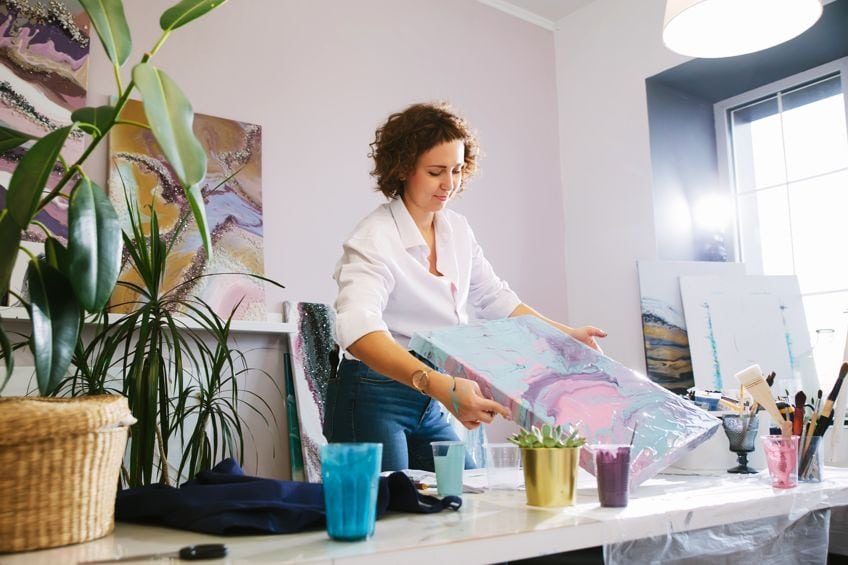
More recently, this method of painting has been revived, with a few advancements in the process. When pouring the fluid paint, it appears smooth and glossy and can create some dramatic, abstract, and contemporary results. Whatever paint pouring techniques you use; you will need to adjust the acrylic paint by adding in the pouring medium. The medium helps to change the consistency so you can pour it smoothly and prevent any cracking once the paint film dries. Once you have poured all of the fluid paint colors, the canvas is then tilted so the paint covers the entire surface, including the sides.
You will achieve varying results due to the type of paint you use as well as the pouring you add and other additives.
Pros and Cons of Acrylic Paint Pouring
Even though acrylic pour painting is something that almost everybody can do, there are a few advantages as well as some disadvantages to fluid art painting. Although, the pros definitely outweigh any cons.
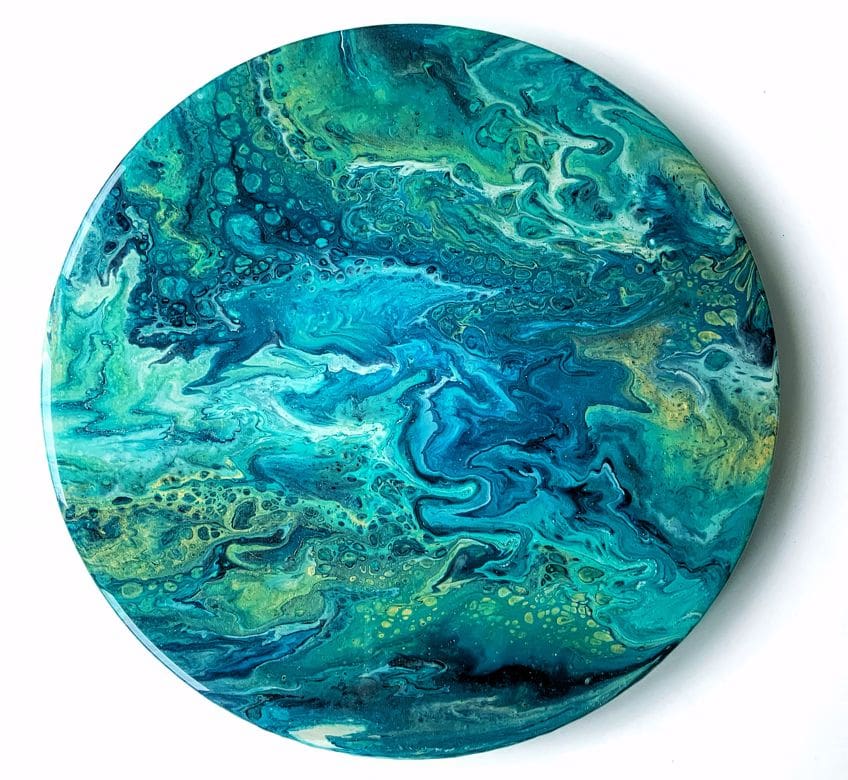
Pros of Acrylic Paint Pouring
First of all, we have already established that acrylic pouring is great for beginners. This is also a good method for those who do not have a lot of time on their hands, as it does not take long to complete a project. You also do not need all that many tools and supplies, and the entire process is simply fun. A few more advantages are included below.
- Perfect for most ages, from young to old can enjoy the benefits of pour art.
- As with most other art forms, it is a great stress reliever.
- There are various acrylic pour techniques, so you can create many different patterns and pours.

- The final painting can be enjoyed in many ways. For example, as a gift or to sell, or to use as a decorative piece around the house.
- Fluid art painting is open to interpretation, so you do not necessarily require any painting skills as you would with normal painting and sketching.
Cons of Acrylic Paint Pouring
There are a few disadvantages when it comes to paint pouring. The chief one is that pouring can get quite messy. You will need a designated space to work, and you will need to cover the painting surface you work on to prevent spills. Some more disadvantages are laid out below.
- There is quite a bit of paint that you use and might waste when you do this type of pour art.
- Some of the supplies and materials needed can be quite expensive.
- It needs quite a lot of time to dry, so when the acrylic pouring is done and drying, it can be damaged. For example, it can be knocked over or dust can accumulate on it.
- It can be a very messy process.

What Materials Are Needed for Fluid Art Painting?
Before you begin your acrylic pouring journey, you need to make sure you have all your supplies ready. You do not want to be in the middle of a pour art project, only to find you need something you forgot to get.
Of course, the most important material in acrylic pour painting is your acrylic paint. Since there are various kinds of acrylic paint, you must choose the best one. For example, you have your heavy body and soft body acrylic paints.

The best option is a soft body as this has a lower viscosity compared to the heavy body acrylics. When pouring, it should go on smoothly and evenly, without bubbles and clumping. You can use heavy body acrylics and student grade acrylics, but both require a lot more pouring medium and cost more as well, so these are not the best option.
Besides the soft body paints, there are now high-flow acrylic paints, and you can use acrylic ink or fluid acrylic paints. The colors used are completely your choice. When starting, maybe try not to use too many colors as the result could become too busy.
Some of the more popular paints include metallic and glitter paints, which add an attractive addition to the painting.
Do You Need a Pouring Medium?
Now that you have your paint, you need something that will create the perfect consistency for pouring. The pouring medium is what helps to create the perfect consistency for pouring. As there are various options for pouring medium, we have provided one of the products we recommend below.
The main reason for using a pouring medium is to provide a smooth and even pouring experience. It is important to get a good quality pouring medium if you want the best results, even if it does add to the costs when pouring.

There are cheaper alternatives like Elmer’s glue or PVA glue, but these do not guarantee good results and are unpredictable, with minimal control over what happens. This might be only good for experimentation if you wish to try it.
A good pouring medium will be self-leveling, which also means you will have fewer pockets of air caught in the final painting. The consistency is also accurate, a kind of honey consistency that can adhere to surfaces without being too runny. The professional quality pouring mediums are also archival, which your basic PVA glue is not. Pouring medium also offers these benefits.
- The paint colors remain vibrant
- Proper adhesion is formed
- Correct flow consistency
- Few to no issues with cracking
You can also not simply add water to the acrylic paints to make them thinner. The water does not provide the right consistency, the colors become less vibrant, and you will have a problem with cracking when the paint dries.
The different pouring mediums offer various properties. You can get pouring mediums with varying consistencies from thin to thick. Some pouring mediums have an additive that makes it glossier, while others dry but remain sticky so make sure to get a medium that will dry hard.
The flowability of the medium is important, and some mediums have perfect and even distribution of the paint, while others are more difficult to work with.
You should also look out for pouring mediums that are archival or provide UV protection. Another difference in pouring mediums is drying times, some dry overnight, while others can take days to dry. You can also use a heat gun to fasten up the drying process a bit, but it’s better to let it dry naturally to help avoid cracks.
Best Pouring Medium: LIQUITEX Professional Pouring Medium
The Liquitex pouring medium will create an even, flexible, and high gloss pour every time. The pouring medium can be used with all acrylic pour techniques and will not cause any cracks or bubbles once the painting has dried. When it does dry, your painting will have a nice wet and glossy appearance. The pouring medium will also not yellow over time and becomes water-resistant when dry.
- A fluid medium with acrylic polymer and high resin solids
- Creates even puddles, poured sheets, and flowing applications
- Mix with Soft Body Acrylic to promote drying with an even film
- Professional quality
- Glossy and even finish
- Provides the correct paint flow
- Little to no cracking or bubble issues
- Colors remain vibrant
- Expensive
- You will need to use gloves
Canvas or Substrate
You can do acrylic pouring on almost any surface as long as it has been properly prepared or primed. Many prefer to pour onto stretched canvas, while others may like canvas boards, painting panels, wooden painting panels, or gesso board, which is a wooden board that has been pre-primed. Some of these surfaces are more rigid than others.
Since you are going to be using a lot of paint on the surface, the painting ground is important. This is simply a layer that is applied that offers support when painting and is usually water-resistant. When purchasing your surface to work on, you can always check to see if it has already been primed.
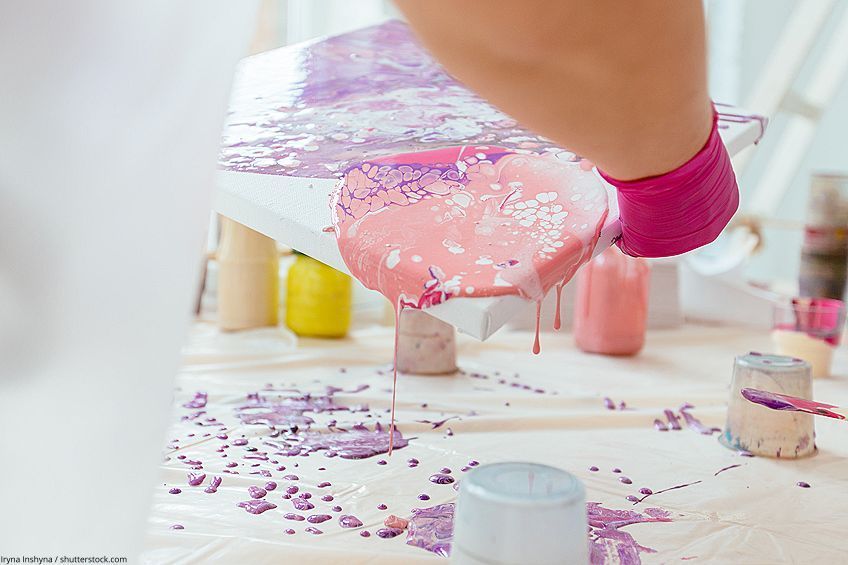
You should always prepare the surface before painting. If you do this, you can pour onto things like cups, trays, tables, or glass. If you choose a canvas that is not pre-primed, you will need to prime it yourself. You can do this by using Gesso, which assists with the adhesion of the paint onto surfaces. Also, the paint will not sink into the substrate, so you have a nice smooth and even surface.
Paint pouring does use a lot of paint, which can weigh a considerable amount when pouring. The stretch canvases are hollow at the back with pieces of wooden stretches. If you do a heavy pour, the paint can cause sagging to occur, which will create an uneven pour. If left, the dried paint is more likely to crack. Simply place a flat card or firm flat object to brace the back of the canvas.
There are also things like wooden canvas keys that help to keep the canvas tension at appropriate levels.
Other Acrylic Pouring Materials
You can also add in some accessories for acrylic pour painting. The most common and easiest item you can use is the paper cups, which you can use for various acrylic pour techniques. You can also use palette knives, spatulas, or stirring sticks, which are perfect for mixing and making an even surface of the paint. To keep the paint in and to help with pre-mixing colors, a squeeze bottle with measurements on the side can help provide more accurate amounts of paint.
You will also need newspapers or old sheets; you could also use plastic sheeting or a tray for smaller pours. These will help to keep the mess to a minimum and make things easier to clean up afterward and protect the surfaces you are working on.

The paint usually has to pour or fall off the sides, so it needs to be elevated slightly so the paint can reach all sides and does not stick to the bottom. To do this, you can use glasses, tins, or jars that you can place the canvas on. You also get specific canvas stands you can purchase. As long as the canvas remains even while doing so. Another item you will need is gloves, as this is messy work, you do not want to have to struggle to get paint off your hands after you are done.
As you gain more experience, you might include other materials like a blow torch, or silicone oil. The blow torch and the heat it produces help to prevent bubbles and also help prevent certain defects from forming. The heat also allows the lighter colors to rise to the surface.
The silicone oil rises to the surface when poured and creates circular cells, which can also reveal other layers of color beneath. This is quite a popular and striking acrylic pour technique.
You can get both high viscosity and low viscosity silicone oil. Both of these produce different results, the high viscosity oil generally produces many smaller cells, while the low viscosity will produce larger cells.
An Acrylic Pour Painting Tutorial
Now you have all your supplies and materials ready, you need to prepare a working area. You will need to lay down plastic sheeting, even on the floor, if necessary. Dried acrylic paint is very difficult to remove from surfaces. Once this is done, gather all your other necessary materials, paints, and cups, so that everything is easy to reach.

Before you begin, put on some gloves, which help protect you from getting paint on your skin and hands. Once placed on your object that elevates your canvas, you can also check that the panel or canvas is even with a spirit level. You want to make sure it will be level, otherwise, the paint might pool, or runoff and you have done everything for nothing. Whatever surface you are going to paint on, it needs to be clean.
Remove any dust and, if necessary, grease, for a clean and smooth surface. Any grease left on the surface will reduce the chances of the paint holding onto or securely remaining on the surface.
Mixing the Acrylic Paints
The basic guide for mixing is quite simple, place some of your acrylic paint into your cup, and then add in the same amount or double the amount of pouring medium. The amount of medium will depend on the type of pouring medium you choose to use. The aim is to get a paint consistency that is similar to honey, not too thin and not too thick. You can also add a little water and mix to reach the correct consistency.

After you have the proper consistency, you can then include silicone oil. This is optional, and you can add in one or two drops and mix. Let the paint mixture stand a little so that the bubbles can come out and you can get rid of them. Many even prepare their pouring mixture a day in advance to avoid bubbles. If you are in too much of a hurry and you pour straight away, you are more than likely going to get pockmarks or pits everywhere.
Determining the Mixing Ratio
You might be wondering how much paint and medium to use? Can you simply guess or is there a way to determine accurate amounts? Achieving the correct ratio does involve some practice as it does depend on the consistency of both the paint and medium used.
A general method does include using one part acrylic paint and one part pouring medium, which is a 1:1 ratio. Mix this ratio and test the consistency. However, if it still seems too thick, you can add in a little more medium or water. Remember, you can only add in 30 percent of total water.
The correct consistency is what makes the perfect pour, if you make it too thin, you will not get the nice patterns and the paint will run all over the place.
Too thick, the paint becomes difficult to spread evenly and you also will not get the patterns you want. Once you determine the correct consistency with the products you are using, it is easy to get the same results in the future.
As a reference for beginners, there are some general methods you can use to get the correct consistency. Below are some recommendations for using different pouring mediums. One is using Floetrol, which is a paint additive that improves the workability of water-based paints, the other is your professional pouring medium, and an alternative using glue. First, mix the paint and medium, and then add the water.

- Professional Pouring Medium: One part paint, one and a half parts medium, and half water.
- Floetrol: This is the same as for the above. Add one-part paint, one and a half parts medium, and half part water.
- Glue: As mentioned, this could be Almer’s glue or PVC glue. Add in one part paint, one and a half parts medium, and one part water.
An even simpler way to determine the ratio is to use a pouring calculator. You will just need to fill out some pertinent information like the length and width of your substrate, and it will determine the amount of paint needed.
Paint Pouring Techniques
Since this is an article for beginners, we will be dealing with a basic tutorial on the traditional acrylic pour. However, there is also a list of some more advanced paint pouring techniques as well. The traditional method is quite simple, all you need is to mix your paint in different cups, and then you pour the paint colors individually onto the canvas. It is harder to create more complex designs this way, but it does provide more control over where the colors go, and it is perfect as a starting point for acrylic pour painting.
Once you have added your paints, you can pick up the canvas and tilt it in various ways to form basic patterns.
Remember, to let the paint run over the edges to cover the sides as well, for a more finished result. The traditional method is great for getting the feel of the paint on the canvas and how to manipulate it without adding in any additives or doing any other more challenging acrylic pour techniques. Once you have the traditional method perfected, you can move on to other pour techniques.
Dirty Acrylic Pour Technique
This method is a variation of your traditional pour. You follow the same steps by pouring paint into separate cups. However, instead of pouring them onto the canvas separately, you take a larger container and pour or layer each color in there. Then you take the single cup with all the paint and pour this over the canvas. You create more colors during this process, but you have less control over where the colors go. You should also learn a little about color theory, to avoid creating any undesirable colors.
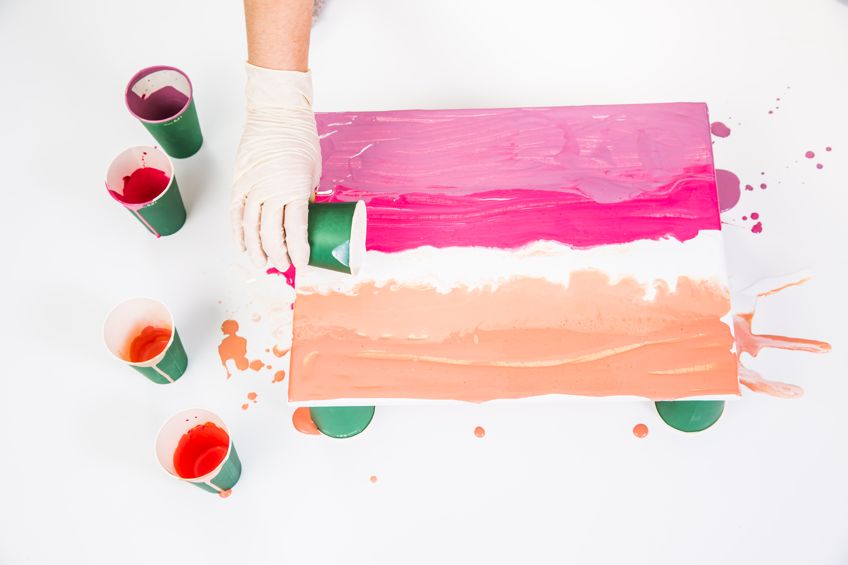
How you pour the different paints into the single cup will have a part to play in the final look of the pour. You can experiment to see what happens by pouring down the side of the cup or pouring into the middle of the cup. The speed at which you pour can also have an effect. Pouring faster will make the paint sink to the bottom, while the paint will sit more on top if poured slower. Once you have poured the paint onto the canvas, again, take it and tilt it to make sure the entire surface is covered.
Puddle Pouring Technique
This is also a slight variation from the traditional pour. You fill all your cups with the different colors of paint, but instead of pouring colors across the canvas, you pour a puddle of paint and within this puddle, you pour more colors, so the paint expands. You can choose to pour larger amounts of paint or smaller amounts of different paint for more variations in color.
When you tilt the canvas all the paints will merge, creating various patterns.
Tree Ring Pouring Technique
This begins in the same way as your dirty pour, with layers of paint in a single cup. Once you have prepared your paint, pour it over the center of your canvas slowly. Then, you can move slowly in a circular motion, which you will notice creates the rings. You can also move it back and forth slightly as you maintain a steady flow of paint.

The slower you can pour, the better the rings will come out. As you pour, the paint will expand over the canvas and look like the rings of a tree. Once you have done pouring, you can also slowly tilt the canvas in all directions to cover the entire surface. The movement is slow because you want to conserve the shape of the rings. You can also leave out the tilting of the canvas to keep the rings at their best, but you will most likely need quite a lot of paint to do this.
You can also do what is known as wreck-a-ring-pour. Before you tilt the canvas and after you have formed the rings, use a stick or other implement to draw lines through the paint. When tilting the canvas, it produces unique patterns.
Flip Cup Pouring Technique
Yet another variation of your dirty cup pouring technique. Once you have prepared your single cup with all the layered paint colors, you can try and flip the cup quickly and directly onto the center of the canvas or you can first flip the cup by placing a piece of cardboard on top of the cup first like a lid and then flipping it over and 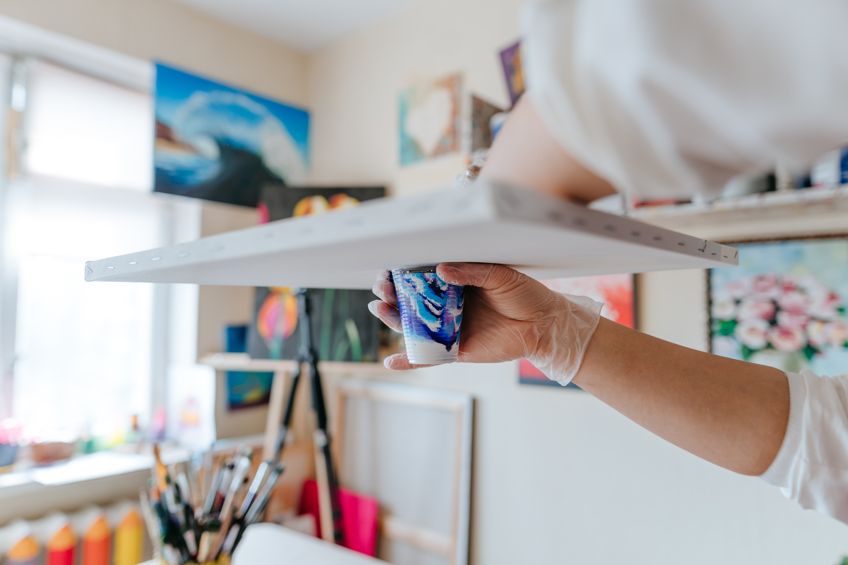
Wait a little bit, until all the paint has shifted down, a clear cup helps best for this. Once it looks like the paint is ready, lift the cup off the canvas or pull the cardboard out while you lift the cup. The paint should pour out and expand on the surface. You can then slowly tilt the canvas so that the paint flows over the whole canvas surface and sides. You can attempt making paint cells by placing the heavier paint at the bottom of the cup before flipping and pouring.
This technique may become a little messy if done incorrectly and you also need to understand the effects of the different color combinations.
Making Use of Other Accessories During a Pour
The above is your beginner pouring techniques, and once you have these perfect, you can move on to other more advanced techniques. Many of these paint pouring techniques require the use of ordinary materials and items found around the home. There are now also specific acrylic pouring strainers available, designed to give different patterns when pouring.

Using a Colander
You will be using a simple colander for this technique, which can create a kaleidoscope type of effect. The paint is prepared as you do for a dirty cup pour, you then place the colander in the center of your prepared canvas, or you can experiment with placing it elsewhere. Whatever you decide, will change the final look of the pour.
Transfer some of the paint from the cup and place it in the colander and allow the paint to seep out.
You can then very slowly lift the colander so that all the paint can drip out onto the canvas. The design will radiate from the point you placed the colander. You can then slowly tilt the canvas to get the paint to flow over the entire surface. You can experiment with smaller and larger colanders as well as different size holes for different effects.
Funnel Pouring
To do this paint pouring technique, you can use a funnel or bottle that can also work. The method is almost like your dirty pour, but you add the paint to the funnel instead of a cup. Simply take the funnel and place it into a position on your canvas, your pattern will radiate from here. You can either hold the funnel so that the opening is closed on the canvas, or you can close the hole with your finger, which prevents the paint from spilling out. Add or layer in your acrylic paint colors as you would do for a dirty pour.
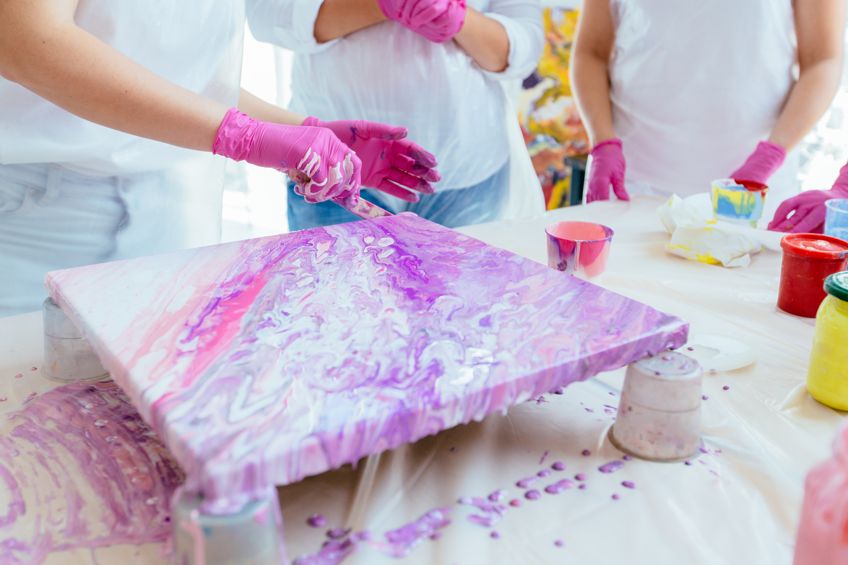
Always consider the colors and how you layer them, as this will form your color patterns. On the spot where you want to begin, in this case in the center as you are going to spiral out, lift or remove your finger to allow the paint to escape. You can then shift the funnel to create a spiral pattern, which forms your puddles of paint. Continue until the paint in the funnel is finished or until you are happy with the pattern formed. You can then slowly remove the funnel, making sure you do not leave behind any unwanted drips.
If you have used enough paint to cover the entire area and you are happy, then that will be your completed pour. However, you can also tilt the canvas if you have only covered a certain area so that the paint can move over the entire surface. Another popular idea is to take a straw and blow the paint across the canvas to create even more patterns.
String Pull Acrylic pour
This can be a little more challenging as the method is a little different from the others we have already covered. You will have to get yourself a length of string or strings, as well as some acrylic paint with a medium. If you are doing multiple colors, keep each color in a separate cup. You can place your piece of string in each paint color. The length of the string can be established by knowing the canvas size. Once the string has been coated with paint, you can remove it from the paint and place them somewhere close.
Next, you need to apply a base coat of paint to the canvas, this must be a contrasting color so that the string design can stand out. Preferably do this before you coat your string.
Pour the paint and cover the canvas surface, you can even out the paint with a palette knife.
Carefully take the end of a piece of paint-coated string and place it onto the canvas in any way you wish, making sure the end piece of the string hangs over the edge. Slowly place all the paint-covered strings onto the canvas in the shape of your chosen pattern.
Once done, the piece of string that is off the edge of the canvas can be grasped and pulled. Pull in a straight consistent line down until the string is off the canvas. The design left behind should be a leaf-like or spiral pattern. As mentioned, this is a more challenging technique and may require some practice to get right. The paint consistency has to be perfect to get the best patterns.
Balloon Dip Acrylic Pour Technique
This may be a bit more challenging than it seems. In theory, it is quite simple, you cover your canvas with a prepared pouring paint mixture. Take a palette knife and even out the paint, making sure to cover the sides and edges as well. You should also have some separate colors of paint mixture ready. You can use these to create puddles on the surface. Include as many puddles as you like to form the desired pattern.
This is where the balloon comes into the picture; take a blown-up balloon and press this into the puddles you formed. You can use more than one balloon or simply wipe the balloon you are using before pressing down onto the next puddle. Balloon dipping can make really interesting effects, like the one below.
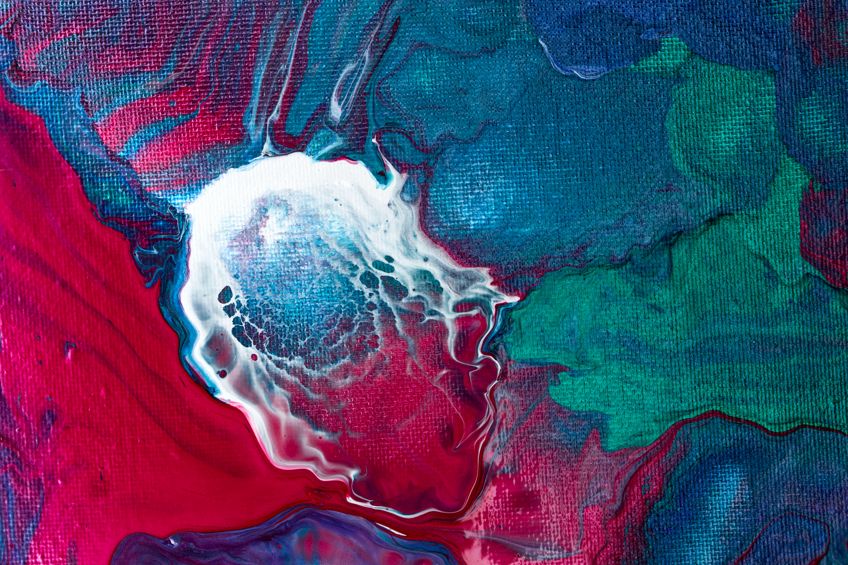
You can leave it there, or you can also pour some of the prepared mixed paint into another bowl. Then dip the balloon into the paint and press lightly into areas on the canvas. As acrylic pouring is a lot about experimentation, you can carry on until you are happy with the results.
You can also enhance the process by using a straw to blow in certain areas you think the design needs a bit of adjustment. You can then use a blow torch if you wish and then leave the paint to dry. You can also include additives like silicone oil for added effect.
More Paint Pouring Techniques
The list above of acrylic pour techniques is only a few and there are many more. On your journey of acrylic pour painting, you may even discover a technique yourself. Until then, here is a shortlist of more techniques.
- Flower pouring
- Swipe method
- Wing pouring technique
- Ghost pouring
- Fractal dendrite technique
- Wave pouring

- Web, infusion, or injection pour technique
- Double-cup pour
- Dutch pour
- Chain pull, similar to the string pull
- Dip canvas method
- Blob Painting
Finishing Touches
Once you have done your acrylic pour painting, you will need it to dry, which can be done in 24 hours. However, if your paint layers are particularly thick, you can leave them for a further 48 hours. During this time, the paint can still shift and move around, so it is important to keep it level and stable while drying. You do not want to come back to a piece that looks completely different from what you started with. Including additives, could also lengthen the drying time, so it is best to leave the painting for as long as possible to dry thoroughly.
You should also try to cover your painting so that no dust or dirt can get onto the wet painting while it is drying. A small enough painting can be covered with a box, otherwise, a larger painting will require a bit more ingenuity. For example, you can create a plastic tent from plastic sheeting.
Also, if you are doing more than one pour onto a single surface, allow enough time for the layers to dry a little before moving on. When the first layer is not dry enough, and you pour over another wet layer, it can cause cracking in your final piece. Once the paint has dried, you can finish off the acrylic painting with a protective layer of finish. These can be water or oil-based, or even resin-based finishes. These finishes also have options, so you can choose a satin or glossy finish or maybe go for a matte finish. This final step provides durability and protects the painting.
Acrylic Pouring Tips and Tricks
When you are a beginner in acrylic pouring, you will need as many tips and tricks as well as advice to create your paintings. Luckily, many artists have already been and done many acrylic pours and found out what works and what will not work. So, here are a few of these tips and tricks.
- Always have enough paint for a pour. It is okay if you have too much but if you have too little, it can be a problem. Some online pouring calculators can help make things easier for you., so you do not sit with problems.
- You can pre–mix your acrylic paint in advance. This is especially helpful if you tend to mix too much paint to begin with and saves you time in the future. Make sure to include distilled water in the mixture to prevent mold from forming. Squeeze bottles come in handy for premixed
- Minimize waste by using reusable tools like silicone cups and sticks or spoons. Avoid doing pours that waste too much paint and always make just enough for each pour.
- Your canvas should always be level and stable for pouring and drying.
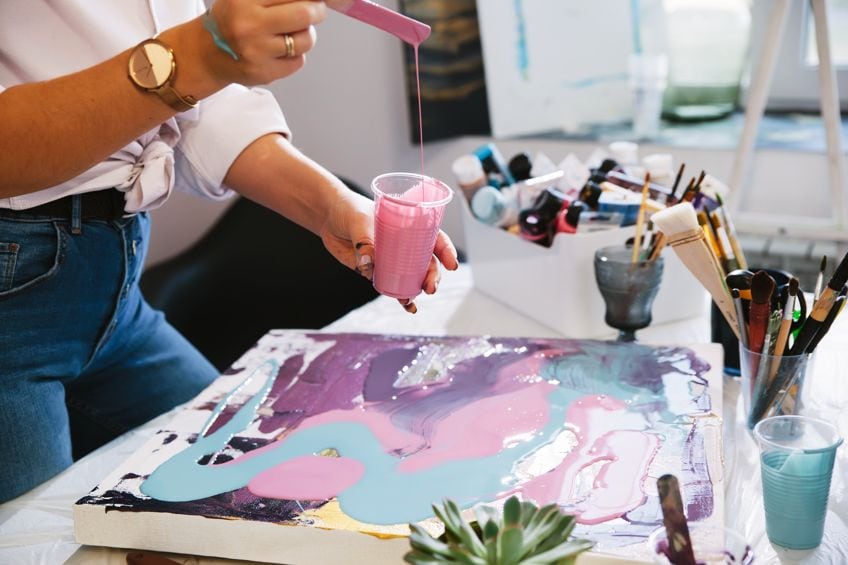
- Do not throw excess paint down the drain. This is not environmentally friendly, rather place the wet paint in some cat litter and let it dry and throw it out with your regular waste. You can also dry the paint in a tin or container, the water will evaporate and what is left you can throw in the trash.
- You can create your own acrylic pour container or drip tray that can help keep your workspace free of messes.
- Get rid of drips from the canvas edge with your gloved finger. While drying, these drips can continue to pull or shift the paint.
- Remember to keep the addition of water to your acrylic paint mixture to only 30% of the total volume. Try to only add pouring medium first to reach the correct consistency, if possible.
- When choosing a pouring medium, consider the consistency. This is because different pouring mediums can have different consistencies, which will affect the acrylic pouring.
- Always elevate your canvas or painting substrate when pouring so the paint can flow over the edges.
- Make sure you know how the colors will interact with each other.
- You can minimize bubbles by using a toothpick to pop the bubbles, or use spray alcohol on the surface, or you can use a small blow torch.
When attempting fluid art painting, the key is to have fun and to experiment with all the various paint pouring techniques. The best part of acrylic pouring is exploring and uncovering all the unusual patterns you can create. Each paint pouring is a unique experience and an original painting.
Frequently Asked Questions
What Is Paint Pouring?
Acrylic pour painting is an art form that uses an acrylic paint mixture that is fluid, which you pour over a canvas using various paint pouring techniques. A pouring medium usually has to be used with the paint. You can pour it onto various surfaces like canvas, wooden panels, boards, and even glass. The surface has to be properly prepared or primed before you begin painting.
What Is a Pouring Medium?
Since acrylic paint can be quite thick, to get the various patterns you usually do for pouring, the paint has to be more fluid. To help with this, there are various painting mediums available, which need to be added to the acrylic paint before doing a pouring. You get professional pouring mediums, and alternatives like Floetrol and even glue.
Why Is a Blow Torch Used in Acrylic Pouring?
Sometimes bubbles can form while you are busy pouring the acrylic paint mixture. The blowtorch is used to prevent unwanted bubbles from forming and helps the lighter paint colors to reach the surface from under heavier paint colors. A hairdryer can also be used for this purpose.
What Are the Best Paints for Acrylic Pouring?
When pouring, acrylic paints are your best option. However, there are different types of acrylics from heavy body to soft body, and professional and student grades. The more common option is your soft body acrylics as they are less viscous and require less pouring medium, while heavy body acrylics need a lot more medium. Costs can also play a part as many of the paints cost a lot more than others.
In 2005, Charlene completed her Wellness Diplomas in Therapeutic Aromatherapy and Reflexology from the International School of Reflexology and Meridian Therapy. She worked for a company offering corporate wellness programs for a couple of years, before opening up her own therapy practice. It was in 2015 that a friend, who was a digital marketer, asked her to join her company as a content creator, and this is where she found her excitement for writing.
Since joining the content writing world, she has gained a lot of experience over the years writing on a diverse selection of topics, from beauty, health, wellness, travel, and more. Due to various circumstances, she had to close her therapy practice and is now a full-time freelance writer. Being a creative person, she could not pass up the opportunity to contribute to the Art in Context team, where is was in her element, writing about a variety of art and craft topics. Contributing articles for over three years now, her knowledge in this area has grown, and she has gotten to explore her creativity and improve her research and writing skills.
Charlene Lewis has been working for artincontext.org since the relaunch in 2020. She is an experienced writer and mainly focuses on the topics of color theory, painting and drawing.
Learn more about Charlene Lewis and the Art in Context Team.
Cite this Article
Charlene, Lewis, “Acrylic Pour Painting – Paint Pouring Techniques Guide.” Art in Context. April 12, 2022. URL: https://artincontext.org/acrylic-pour-painting/
Lewis, C. (2022, 12 April). Acrylic Pour Painting – Paint Pouring Techniques Guide. Art in Context. https://artincontext.org/acrylic-pour-painting/
Lewis, Charlene. “Acrylic Pour Painting – Paint Pouring Techniques Guide.” Art in Context, April 12, 2022. https://artincontext.org/acrylic-pour-painting/.








